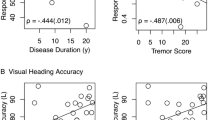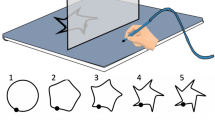Abstract
Patients with Williams–Beuren Syndrome (WBS, also known as Williams Syndrome) show many problems in motor activities requiring visuo-motor integration, such as walking stairs. We tested to what extent these problems might be related to a deficit in the perception of visual depth or to problems in using this information in guiding movements. Monocular and binocular visual depth perception was tested in 33 patients with WBS. Furthermore, hand movements to a target were recorded in conditions with and without visual feedback of the position of the hand. The WBS group was compared to a group of control subjects. The WBS patients were able to perceive monocular depth cues that require global processing, but about 49% failed to show stereopsis. On average, patients with WBS moved their hand too far when no visual feedback on hand position was given. This was not so when they could see their hand. Patients with WBS are able to derive depth from complex spatial relationships between objects. However, they seem to be impaired in using depth information for guiding their movements when deprived of visual feedback. We conclude that the problems that WBS patients have with tasks such as descending stairs are not due to an inability to judge distance.






Similar content being viewed by others
References
Atkinson J, King J, Braddick O, Nokes L, Anker S, Braddick F (1997) A specific deficit of dorsal stream function in Williams’ syndrome. Neuroreport 8:1919–1922
Atkinson J, Anker S, Braddick O, Nokes L, Mason A, Braddick F (2001) Visual and visuospatial development in young children with Williams syndrome. Dev Med Child Neurol 43:330–337
Atkinson J, Braddick O, Anker S, Curran W, Andrew R, Wattam-Bell J, Braddick F (2003) Neurobiological models of visuospatial cognition in children with Williams syndrome: measures of dorsal-stream and frontal function. Dev Neuropsychol 23:139–172
Bellugi U, Bihrle A, Jernigan T, Trauner D, Doherty S (1990) Neuropsychological, neurological, and neuroanatomical profile of Williams syndrome. Am J Med Genet Suppl 6:115–125
Bellugi U, Lichtenberger L, Mills D, Galaburda A, Korenberg JR (1999) Bridging cognition, the brain and molecular genetics: evidence from Williams syndrome. Trends Neurosci 22:197–207
Bellugi U, Lichtenberger L, Jones W, Lai Z, St George M (2000) The neurocognitive profile of Williams Syndrome: a complex pattern of strengths and weaknesses. J Cogn Neurosci 12:7–29
Bihrle AM, Bellugi U, Delis D, Marks S (1989) Seeing either the forest or the trees: dissociation in visuospatial processing. Brain Cogn 11:37–49
Braddick O, Atkinson J, Wattam-Bell J (2003) Normal and anomalous development of visual motion processing: motion coherence and “dorsal-stream vulnerability”. Neuropsychologia 41:1769–1784
Chapman CA, du PA, Pober BR (1996) Neurologic findings in children and adults with Williams syndrome. J Child Neurol 11:63–65
Davies M, Udwin O, Howlin P (1998) Adults with Williams syndrome. Preliminary study of social, emotional and behavioural difficulties. Br J Psychiatry 172:273–276
Farran EK, Jarrold C, Gathercole SE (2001) Block design performance in the Williams syndrome phenotype: a problem with mental imagery? J Child Psychol Psychiatry 42:719–728
Francke U (1999) Williams–Beuren syndrome: genes and mechanisms. Hum Mol Genet 8:1947–1954
Van der Geest JN, Lagers-van Haselen GC, van Hagen JM, Govaerts LCP, de Coo IFM, de Zeeuw CI, Frens MA (2004) Saccade dysmetria in Williams-Beuren syndrome. Neuropsychologia 42:569–576
Goodale MA, Milner AD (1992) Separate visual pathways for perception and action. Trends Neurosci 15:20–25
Hoogenraad CC, Koekkoek B, Akhmanova A, Krugers H, Dortland B, Miedema M, van Alphen A, Kistler WM, Jaegle M, Koutsourakis M, Van Camp N, Verhoye M, van der Linden A, Kaverina I, Grosveld F, De Zeeuw CI, Galjart N (2002) Targeted mutation of Cyln2 in the Williams syndrome critical region links CLIP-115 haploinsufficiency to neurodevelopmental abnormalities in mice. Nat Genet 32:116–127
Kapp ME, Von Noorden GK, Jenkins R (1995) Strabismus in Williams syndrome. Am J Ophthalmol 119:355–360
Korenberg JR, Chen XN, Hirota H, Lai Z, Bellugi U, Burian D, Roe B, Matsuoka R (2000) Genome structure and cognitive map of Williams syndrome. J Cogn Neurosci 12:89–107
Kovacs I, Lukacs A, Feher A, Racsmany M, Pleh C (2001) Contour integration deficit in Williams Syndrome children [Abstract]. J Vis 1(3):146 (see http://journalofvision.org/1/3/146)
Lashkari A, Smith AK, Graham JM Jr (1999) Williams–Beuren syndrome: an update and review for the primary physician. Clin Pediatr 38:189–208
MacDonald GW, Roy DL (1988) Williams syndrome: a neuropsychological profile. J Clin Exp Neuropsychol 10:125–131
Meng JC, Sedgewick HA (2001) Distance perception mediated through nested contact relations among surfaces. Percept Psychophys 63:1–15
Mervis CB, Robinson BF, Bertrand J, Morris CA, Klein-Tasman BP, Armstrong SC (2000) The Williams syndrome cognitive profile. Brain Cogn 44:604–628
Morris CA, Mervis CB (2000) Williams syndrome and related disorders. Annu Rev Genomics Hum Genet 1:461–484
Nakamura M, Watanabe K, Matsumoto A, Yamanaka T, Kumagai T, Miyazaki S, Matsushima M, Mita K (2001) Williams syndrome and deficiency in visuospatial recognition. Dev Med Child Neurol 43:617–621
Nakamura M, Kaneoke Y, Watanabe K, Kakigi R (2002) Visual information process in Williams syndrome: intact motion detection accompanied by typical visuospatial dysfunctions. Eur J Neurosci 16:1810–1818
Von Noorden GK (1996) Binocular vision and ocular motility: theory and management of strabismus. Mosby, St Louis, MO
Ohlsson J, Villarreal G, Abrahamsson M, Cavazos H, Sjostrom A, Sjostrand J (2001) Screening merits of the Lang II, Frisby, Randot, Titmus, and TNO stereo tests. J Am Assoc Pediat Ophthalmol Strabismus 5:316–322
Olitsky SE, Sadler LS, Reynolds JD (1997) Subnormal binocular vision in the Williams syndrome. J Pediat Ophthalmol Strabismus 34:58–60
Osborne LR, Martindale D, Scherer SW, Shi XM, Huizenga J, Heng HHQ, Costa T, Pober B, Lew L, Brinkman J, Rommens J, Koop B, Tsui LC (1996) Identification of genes from a 500-kb region at 7q11.23 that is commonly deleted in Williams syndrome patients. Genomics 36:328–336
Paul BM, Stiles J, Passarotti A, Bavar N, Bellugi U (2002) Face and place processing in Williams syndrome: evidence for a dorsal-ventral dissociation. Neuroreport 13:1115–1119
Reiss AL, Eliez S, Schmitt JE, Straus E, Lai Z, Jones W, Bellugi U (2000) IV. Neuroanatomy of Williams syndrome: a high-resolution MRI study. J Cogn Neurosci 12:65–73
Sadler LS, Olitsky SE, Reynolds JD (1996) Reduced stereoacuity in Williams syndrome. Am J Med Genet 66:287–288
Schmitt JE, Eliez S, Warsofsky IS, Bellugi U, Reiss AL (2001) Enlarged cerebellar vermis in Williams syndrome. J Psychiat Res 35:225–229
Stiles J, Sabbadini L, Capirci O, Volterra V (2000) Drawing abilities in Williams syndrome: a case study. Dev Neuropsychol 18:213–235
Trauner DA, Bellugi U, Chase C (1989) Neurologic features of Williams and Down syndromes. Pediat Neurol 5:166–168
Udwin O, Yule W (1991) A cognitive and behavioural phenotype in Williams syndrome. J Clin Exp Neuropsychol 13:232–244
Ullman S (1979) The interpretation of structure from motion. Proc R Soc London B Biol Sci 203:405–426
Withers S (1996) A new clinical sign in Williams syndrome. Arch Dis Child 75:89
Acknowledgements
The authors are grateful to the patients with Williams–Beuren Syndrome and their families for participating in this study. JN van der Geest was supported by grants from the NWO (903-68-394) and the Revolving Fund of the Erasmus MC. MA Frens was supported by a VIDI grant from the NWO.
Author information
Authors and Affiliations
Corresponding author
Rights and permissions
About this article
Cite this article
Van der Geest, J.N., Lagers-van Haselen, G.C., van Hagen, J.M. et al. Visual depth processing in Williams–Beuren syndrome. Exp Brain Res 166, 200–209 (2005). https://doi.org/10.1007/s00221-005-2355-1
Received:
Accepted:
Published:
Issue Date:
DOI: https://doi.org/10.1007/s00221-005-2355-1




